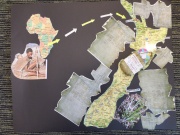Teaching Te Tiriti o Waitangi
Te Tiriti o Waitangi, or the Treaty of Waitangi, is New Zealand's founding document. It was signed on February 6th, 1840. The intention of the treaty was to create a partnership between the British Crown and the Māori chiefs. The treaty was a document conceived with good intentions. The English draft was constructed in a very short time frame and translated overnight into the Māori language by the Reverend Henry Williams and his son Edward. With such a rushed document there were bound to be problems. At Waitangi, the Māori chiefs discussed the treaty in their own language, they understood the contents of the legal Māori version of the treaty, and they signed the legally-binding Māori Te Tiriti o Waitangi. The breaches of the treaty that started shortly after the signing, continue to today. Te Tiriti o Waitangi is important historically, it is important legally, and it is important to every person who lives in New Zealand today.
Te Tiriti o Waitangi can be taught through documents and texts. However, it can also come alive and gain meaning by investing emotionally in a journey of understanding. There is no point reading texts without understanding why the treaty is a vital document. The following lesson ideas were part of a course called "Te Tiriti o Waitangi (The Journey)".
The pages contain ideas for an introductory lecture, tutorials, a field trip, and an assessment event:
